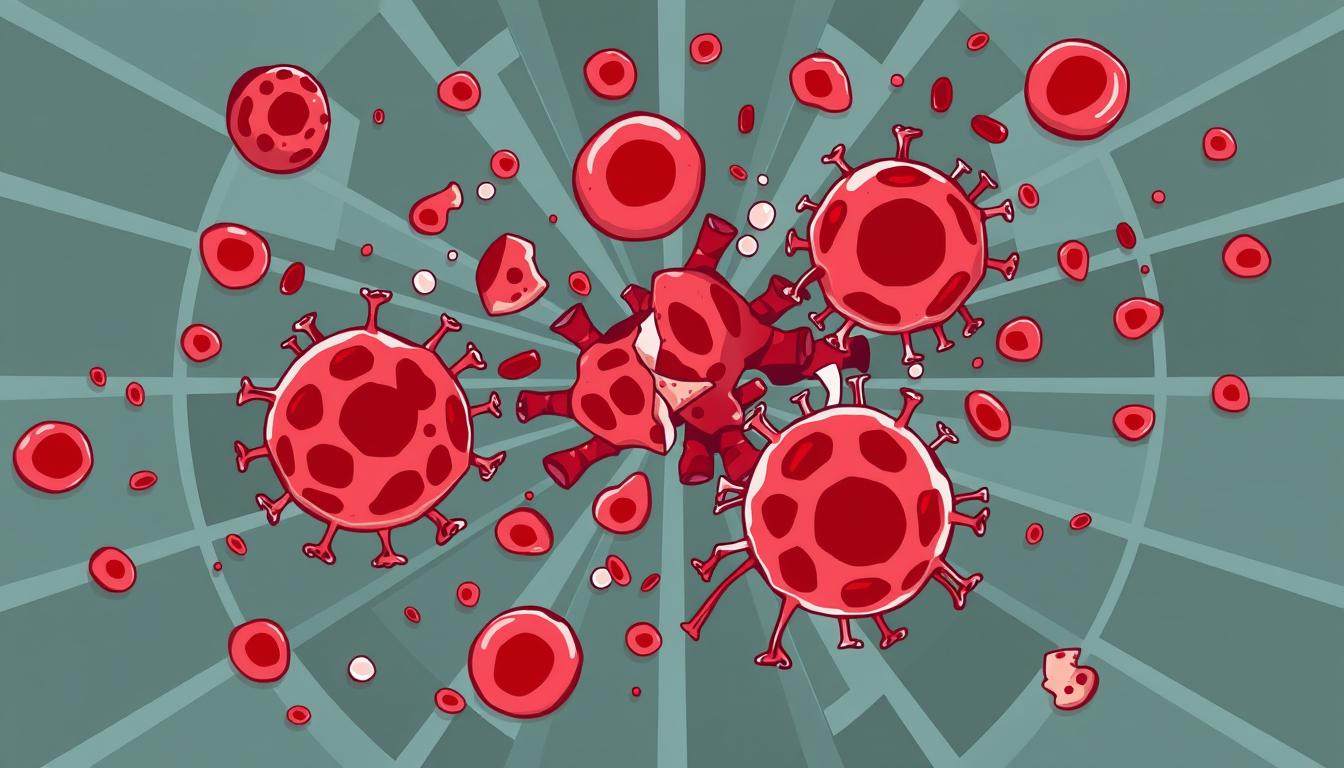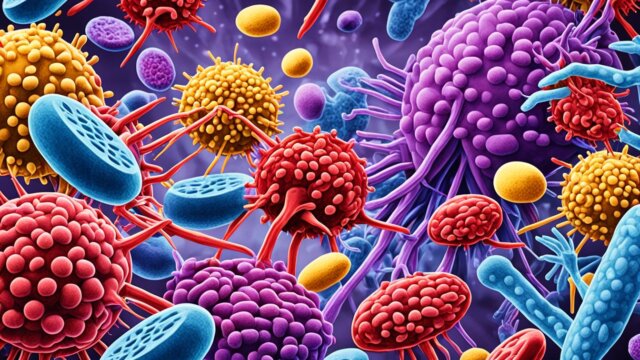FTC disclaimer: This post may contains affiliate links and we will be compensated if you click on a link and make a purchase.
Chronic myelogenous leukemia (CML) is a rare cancer that affects the bone marrow and blood. It’s not common, with only 0.87 people per 100,000 getting it each year. This number goes up with age, especially after 70.
This cancer makes more white blood cells, called granulocytes, than usual. CML is called a “chronic” cancer because it grows slowly. It mostly happens in older adults and is rare in kids, but it can happen to anyone.
Key Takeaways
- Chronic myelogenous leukemia (CML) is a rare type of cancer that affects the bone marrow and blood.
- CML is characterized by an increased number of white blood cells, specifically granulocytes, in the bloodstream.
- CML is considered a “chronic” cancer, meaning it progresses more slowly than other severe forms of leukemia.
- CML is most commonly diagnosed in adults between the ages of 40 and 60, and is uncommon in children younger than 10 years of age.
- The chronic phase of CML may last 5 to 6 years, with the disease progressing very slowly during this time.
What is Chronic Granulocytic Leukemia?
Definition and Overview
Chronic granulocytic leukemia, also known as CML, is a cancer of the bone marrow that affects the production of white blood cells. The bone marrow makes too many immature white blood cells called granulocytes.
This crowds out healthy blood cells. It causes many problems and makes the disease worse.
Types of Leukemia
There are four main types of leukemia: ALL, AML, CLL, and CML. Acute leukemias grow fast, but chronic ones like CML grow slowly. CML is a slow-growing leukemia.
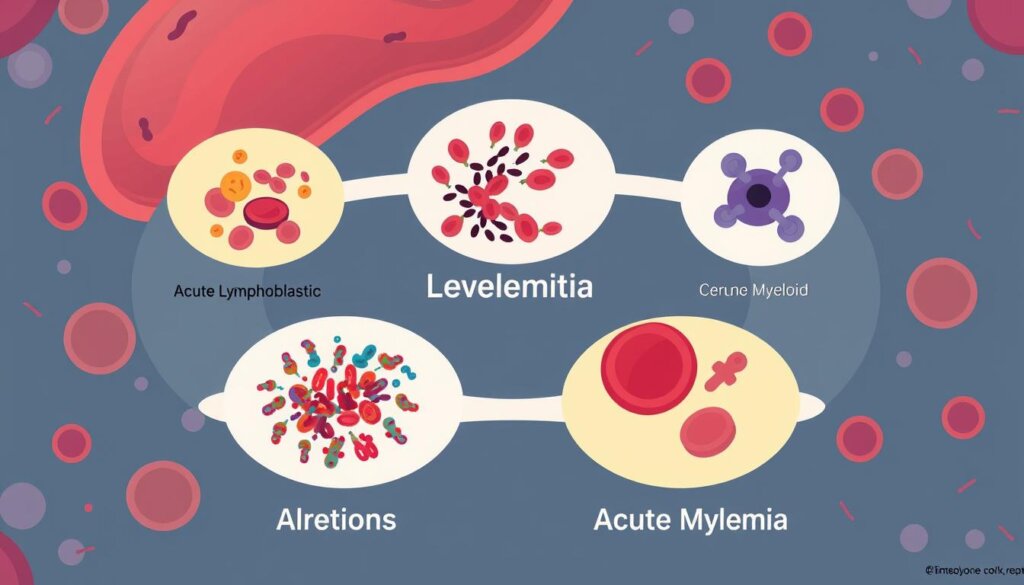
“Chronic myelogenous leukemia is an uncommon type of cancer of the bone marrow.”
CML mostly affects older adults. It rarely happens in kids, but can happen at any age. About 90% of people with CML have a genetic abnormality called the Philadelphia chromosome.
Causes of Chronic Granulocytic Leukemia
Most cases of chronic granulocytic leukemia result from a genetic change called the Philadelphia chromosome. This change happens when parts of chromosomes 9 and 22 swap places, creating a shorter chromosome 22 and a new gene called BCR-ABL.
The BCR-ABL gene makes an abnormal protein called tyrosine kinase. This protein makes white blood cells grow out of control.
The Philadelphia Chromosome
The Philadelphia chromosome is found in most CML patients. CML makes up 15-25% of adult leukemias in Western countries. This genetic change happens after birth, not from parents.
BCR-ABL Gene Mutation
The BCR-ABL gene fusion makes a bad tyrosine kinase protein. This protein makes CML cells grow and divide without stopping. In some cases, the BCR-ABL oncogene is there without the Philadelphia chromosome.
Even fewer cases show symptoms without the Philadelphia chromosome or BCR-ABL oncogene. This suggests other unknown oncogenes might be involved.
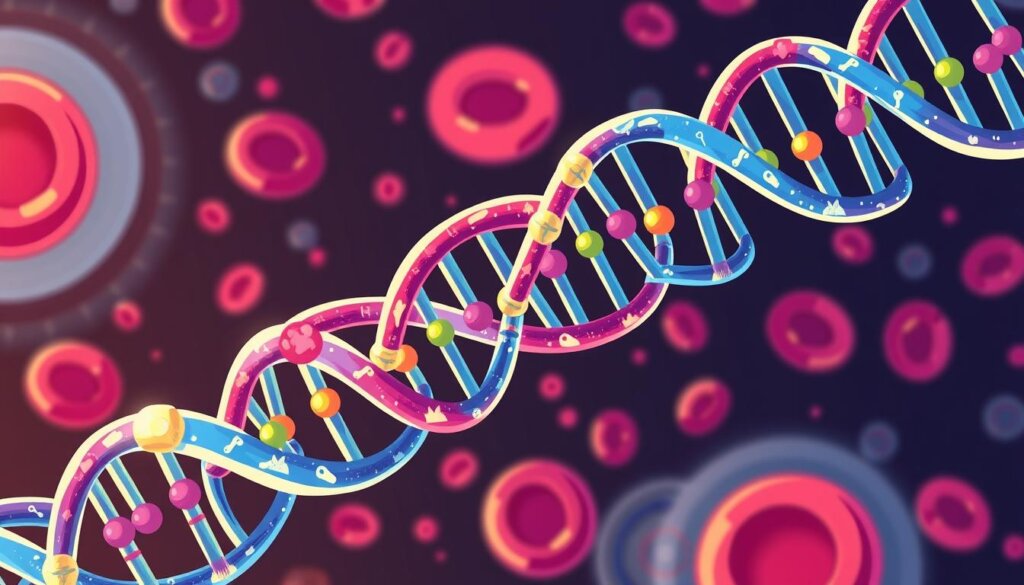
CML is not inherited. The DNA changes happen during a person’s life, not from parents. But, ionizing radiation increases the risk. People exposed to nuclear bombs in Hiroshima and Nagasaki have a 50-fold higher risk of CML.
The genetic changes, like the Philadelphia chromosome and BCR-ABL gene, are key in CML.
Risk Factors
The exact cause of chronic granulocytic leukemia, also known as chronic myelogenous leukemia (CML), is unknown. But, some risk factors have been found.
- Age: The risk of getting CML goes up with age. It’s more common in older adults.
- Gender: CML is a bit more common in males than females.
- Radiation exposure: Being exposed to a lot of radiation, like from atomic bombs, can lead to CML in some cases.
But, getting X-rays or CT scans doesn’t seem to raise the risk of CML much. Also, CML doesn’t seem to run in families.
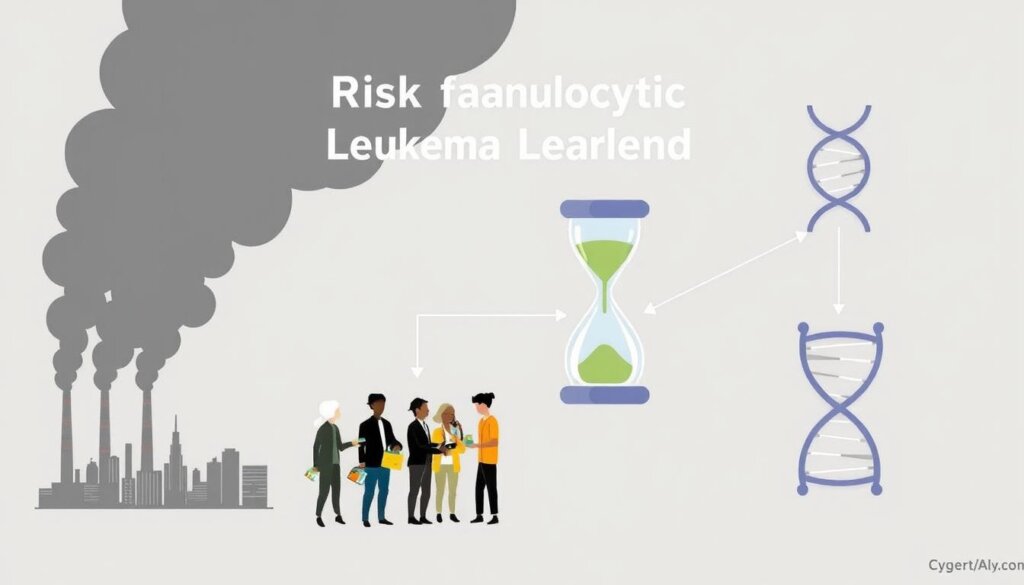
Even though these risk factors are known, most CML cases don’t have any known causes. Knowing these risk factors helps doctors find cases early. They use tests to look for the Philadelphia chromosome.
“The risk factors for chronic myelogenous leukemia can provide important insights, but they do not determine the development of the disease with certainty. Regular medical check-ups and prompt attention to any concerning symptoms are crucial for early detection and effective management of this condition.”
Symptoms of Chronic Granulocytic Leukemia
Chronic granulocytic leukemia (CML) often doesn’t show symptoms early on. But as it gets worse, symptoms can really affect a person’s life.
Common Symptoms
Common signs of CML include feeling weak, tired, and having night sweats. You might also lose weight, have fever, bone pain, and an enlarged spleen. Feeling full after eating and belly pain are also symptoms.
Anemia makes you weak, tired, and short of breath. Low white blood cells and neutrophils raise the risk of getting sick. Not having enough platelets can cause easy bruising and bleeding.
Less Common Symptoms
Some people with CML might have swollen lymph nodes or trouble breathing. They might also have painful erections that last too long, which is a big problem. Headaches, vision changes, and painful joints are other symptoms.
It’s key to remember that these symptoms can mean other things too. If you’re feeling any of these, see a doctor right away for help.
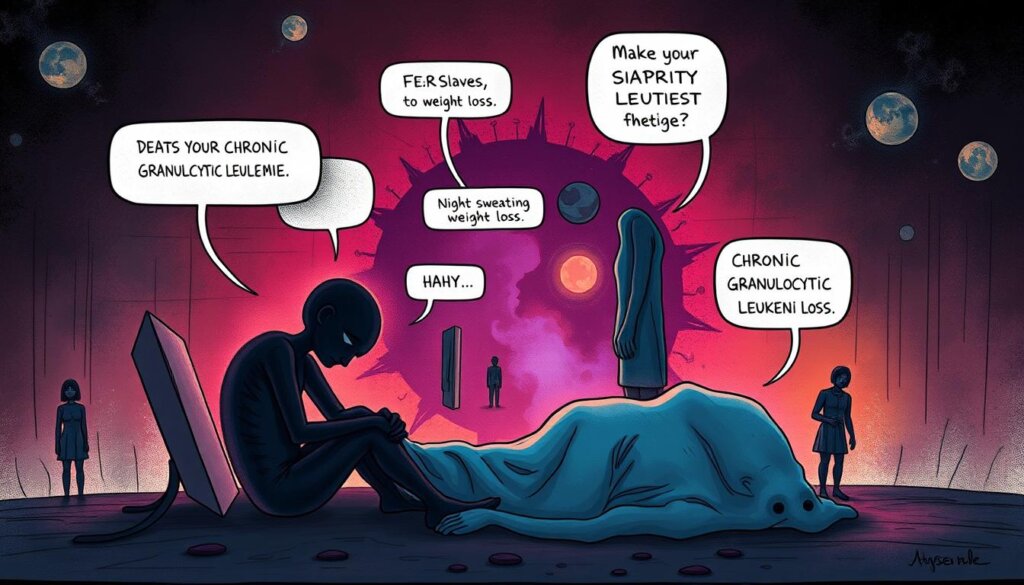
“Many people with chronic myeloid leukaemia (CML) may not exhibit symptoms initially and are often diagnosed through routine blood tests.”
Diagnosis
Chronic myelogenous leukemia, or CML, is diagnosed with blood and bone marrow tests. These tests help doctors understand the disease and plan treatment.
Blood Tests
Blood tests, like the complete blood count (CBC), are key in diagnosing CML. The CBC checks the levels of blood cells. In CML, there are too many white blood cells because of a genetic issue.
Bone Marrow Tests
Bone marrow tests confirm CML. They take a sample from the hip bone to check the marrow. These tests find the genetic signs of CML, like the Philadelphia chromosome.
Tests like FISH and PCR also look for CML’s genetic markers.
“Accurate diagnosis is the foundation for effective CML treatment. The combination of blood tests and bone marrow examinations provides a comprehensive picture of the disease, enabling healthcare providers to develop a personalized care plan.”
Diagnostic Test | Purpose |
|---|---|
Complete Blood Count (CBC) | Assess levels of white blood cells, red blood cells, and platelets |
Bone Marrow Aspiration and Biopsy | Examine the solid and liquid components of the bone marrow for the presence of the Philadelphia chromosome and BCR-ABL gene mutation |
Fluorescence In Situ Hybridization (FISH) | Detect specific genetic abnormalities associated with CML |
Polymerase Chain Reaction (PCR) | Identify the presence of the BCR-ABL gene mutation |
Stages of Chronic Granulocytic Leukemia
Chronic granulocytic leukemia, also known as chronic myeloid leukemia (CML), goes through three main stages. These are the chronic phase, accelerated phase, and blastic phase or blast crisis.
The chronic phase is the first and most stable stage. In this stage, mature blood cells are mostly present. The disease grows slowly, and symptoms are mild. These include feeling tired and having a big spleen.
As CML moves forward, it reaches the accelerated phase. This phase has more immature cells than the chronic phase. Symptoms get worse, like feeling very tired, losing weight, and having a big spleen.
The blastic phase or blast crisis is the last stage. It’s when CML turns into acute leukemia. There’s a big jump in blast cells in the bone marrow and blood. These cells can also spread to other parts of the body. This stage is the most aggressive and dangerous.
Researchers use the European LeukaemiaNet definition in recent CML studies. They look at the number of immature white blood cells and chromosomal changes in leukemia cells. These help figure out the CML phase.
In the chronic phase, patients often have low red blood cells and abnormal platelets. As the disease gets worse, more blasts appear in the blood and bone marrow. The blast phase has 20% or more blasts.
Guidelines and research on CML come from places like the European LeukemiaNet, Annals of Oncology, and the British Journal of Haematology.
Phase | Definition | Characteristics |
|---|---|---|
Chronic Phase | Less than 10% blasts in blood or bone marrow | Mature, fully functioning blood cells predominate; disease develops slowly |
Accelerated Phase | 15% or more blasts in blood or bone marrow | Higher number of immature (blast) cells; more pronounced symptoms |
Blast Phase | 20% or more blasts in blood or bone marrow | Significant increase in blast cells; transformation into acute leukemia |
“Adverse prognostic factors in CML include accelerated phase, enlarged spleen, bone damage, abnormal granulocytes in blood samples, age over 60, and multiple chromosome changes.”
The Sokal system and Euro score help predict CML outcomes. But their value is unclear with new drugs like imatinib.
Chronic Granulocytic Leukemia Treatment
Treatment for chronic granulocytic leukemia, or CML, has changed a lot lately. Now, patients have many new options. These have made treatment better and the outlook for the disease much brighter.
Targeted Therapy
Tyrosine kinase inhibitors (TKIs) are the main treatment for CML in its early stages. Drugs like Imatinib (Gleevec®), Dasatinib (Sprycel®), Nilotinib (Tasigna®), and Bosutinib (Bosulif®) are used first. These drugs have changed how we treat CML, helping many patients stay in remission for a long time.
Chemotherapy
For those who don’t do well with TKIs, other treatments are available. Omacetaxine mepesuccinate (Synribo®) or interferon therapy might be options. If CML gets worse, doctors might use TKIs with or without chemo. Then, they might suggest a stem cell transplant or a clinical trial.
Stem Cell Transplant
Those who don’t respond to TKIs might get a stem cell transplant. This is when a donor’s healthy stem cells replace the patient’s sick ones. It’s like a new start for the immune system and might cure the disease.
Choosing a treatment for CML depends on many things. These include the disease’s stage, test results, and the patient’s health. Regular checks and tests, like BCR::ABL1 kinase domain mutation analysis, are key. They help see if the treatment is working and if changes are needed.
Thanks to new treatments, especially targeted therapies, many patients are doing well. But, CML can come back. So, we need to keep working on new treatments to help patients even more.
Living with Chronic Granulocytic Leukemia
Living with chronic granulocytic leukemia, or CML, can be tough. But, with the right help and ways to manage, many people can live well. The main treatment, tyrosine kinase inhibitors (TKIs), keeps the cancer under control for years. Yet, the cost of treatment is high, even with insurance, and dealing with side effects is a big worry.
To handle the cost of CML treatment, know your copays, deductibles, and other costs before starting. Look for financial help from social workers, care teams, the American Cancer Society, and other groups. Also, think about using generic meds to cut down on costs.
Dealing with side effects like fatigue, nausea, and diarrhea is common in CML patients. To fight these, stay active, eat well, and keep a symptom diary to share with your doctor.
Support groups and counseling are key for those with CML. Knowing about your disease and being involved in your care helps you stick to your treatment plan.
By tackling the physical, financial, and emotional hurdles of CML, patients can keep their quality of life high. Regular check-ups and tests are vital to track how well treatment is working and catch any signs of CML or side effects. With the right support and ways to manage, many with CML can live full lives.
Prognosis and Survival Rates
The outlook for chronic granulocytic leukemia, or CML, has gotten much better lately. With the right treatment, many people with CML can go into remission and live for years. The 5-year survival rate for CML is about 70%.
But, the outlook can change based on the disease stage, how well the treatment works, and other things. People diagnosed in the chronic phase usually do best, with a 5-year survival rate of 88%. Those in the accelerated or blastic phases face tougher challenges, with survival rates of 31.7% for AML and 23.7% for AML-M5.
The arrival of targeted therapies like imatinib (Gleevec®) has been a big help for CML treatment. About 90% of CML patients on imatinib were alive 5 years later. Most also had normal white blood cell counts and chromosome studies after 5 years on imatinib.
New research and treatments are making the future look brighter for CML patients. Survival rates for CML have jumped from less than 20% in the 1970s to about 85% today. The goal now is to get to a point where CML patients can live without treatment, using the immune system to help fight the disease.
Even with challenges like finding a cure and dealing with treatment side effects, the outlook for CML patients is better than ever. Thanks to hard work by researchers and healthcare teams, people with CML can now hope for a better future with more years of life and better quality of life.
Prevention
There’s no known way to prevent most cases of chronic myeloid leukemia (CML). The genetic mutation that leads to CML happens after birth. So, it can’t be predicted. However, reducing high-dose radiation exposure might help lower some risks.
For most people, early detection and prompt treatment are the best ways to manage CML. Regular check-ups and watching for symptoms are key to early diagnosis. Even though there’s no proven prevention, healthy habits like maintaining a healthy weight, eating well, and exercising can lower cancer risk.
Key Strategies for CML Prevention | Potential Impact |
|---|---|
Reduce exposure to high-dose radiation | May lower risk in a small number of cases |
Undergo regular check-ups and monitoring | Enables early detection and treatment |
Adopt healthy lifestyle habits | May help reduce overall cancer risk |
While there’s no sure way to prevent CML, these steps can help manage risk and improve outcomes for those with the disease.
“Ultimately, the best way to address CML is through early detection and effective treatment, rather than relying on preventive measures that have limited impact on this type of leukemia.”
Chronic Granulocytic Leukemia Research
The field of CML research is growing fast. Scientists and doctors are working hard to find new ways to manage this disease. They are studying CML treatments and trying to understand the disease better.
Clinical trials are key in testing new drugs and treatments for CML. These trials give patients early access to new therapies. They help move CML management forward.
Researchers are investigating new treatments and ways to overcome drug resistance. They want to create treatments that work better for each patient, which could greatly improve the lives of those with CML.
Key CML Research Initiatives | Objective |
|---|---|
Targeted Therapies | Develop new drugs that target specific genetic mutations or molecular pathways in CML cells |
Combination Treatments | Evaluate the effectiveness of combining various therapies to enhance treatment outcomes |
Overcoming Drug Resistance | Identify strategies to overcome resistance to existing CML treatments |
Genetic and Molecular Research | Deepen understanding of the genetic and molecular underpinnings of CML to inform more personalized therapies |
The goal of CML research is to make life better for those with the disease. Thanks to hard work, the future looks brighter for CML patients.
“The field of CML research is rapidly evolving, with scientists and clinicians working tirelessly to develop new and more effective treatments for this disease.”
Conclusion
Learning about chronic granulocytic leukemia, or CML, helps you take charge of your health. This disease is becoming more common, especially with new treatments. Finding it early and treating it well is very important.
New treatments have improved the lives of many CML patients. Most people with CML in its early stage can live long lives.
It’s key to watch your health closely and act fast if needed. Tests can find CML early, helping you get the right treatment. Working with your healthcare team is crucial for managing CML well.
Understanding CML means knowing how early detection and new treatments help. It also means staying vigilant and managing your condition. With the right care and support, you can handle CML effectively.
FAQ
What is chronic granulocytic leukemia?
Chronic granulocytic leukemia, or CML, is a rare cancer. It affects the bone marrow and blood. It’s marked by too many white blood cells, called granulocytes.
What are the different types of leukemia?
There are four main types of leukemia: acute lymphocytic leukemia (ALL), acute myeloid leukemia (AML), chronic lymphocytic leukemia (CLL), and CML, also known as chronic granulocytic leukemia.
What causes chronic granulocytic leukemia?
Most CML cases come from a genetic change called the Philadelphia chromosome. This happens when chromosomes 9 and 22 swap parts. It creates a new gene called BCR-ABL.
What are the risk factors for chronic granulocytic leukemia?
Risk factors include age, gender, and radiation exposure. Older age, being male, and high radiation exposure increase the risk.
What are the symptoms of chronic granulocytic leukemia?
Early stages of CML often have no symptoms. Symptoms like fatigue, fever, and weight loss may appear later. Bone pain and an enlarged spleen are also signs.
How is chronic granulocytic leukemia diagnosed?
Doctors use blood and bone marrow tests to diagnose CML. These include a complete blood count and tests for the Philadelphia chromosome and BCR-ABL gene.
What are the stages of chronic granulocytic leukemia?
CML has three stages: the chronic phase, the accelerated phase, and the blastic phase or blast crisis.
How is chronic granulocytic leukemia treated?
Treatment for CML has changed a lot. Now, there are targeted therapies and other options like tyrosine kinase inhibitors, chemotherapy, and stem cell transplants.
How can I manage living with chronic granulocytic leukemia?
Living with CML can be tough, but it’s possible to manage. A healthy lifestyle, managing side effects, and getting support are key.
What is the prognosis for chronic granulocytic leukemia?
The outlook for CML has gotten better. Thanks to new treatments, many patients can live long after diagnosis.
Can chronic granulocytic leukemia be prevented?
There’s no way to prevent CML, as the genetic mutation that causes it occurs after birth. However, avoiding high radiation can help lower the risk a bit.
What is the latest research on chronic granulocytic leukemia?
Research is ongoing to find better treatments and understand CML better. Scientists are looking at new therapies and ways to fight drug resistance.
